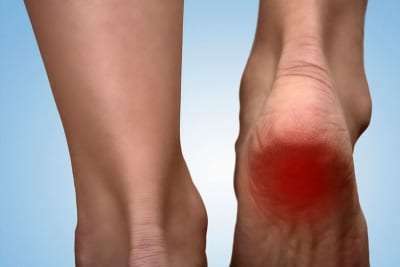 One of the most common sources of pain in the heel of the foot is a heel spur. In fact, heel spurs often show up unexpectedly on X-rays taken during an examination for another problem. Estimates vary, but approximately one out of ten people (10%) have a heel spur; however, only one in twenty people (5%) experience foot pain from a heel spur.
One of the most common sources of pain in the heel of the foot is a heel spur. In fact, heel spurs often show up unexpectedly on X-rays taken during an examination for another problem. Estimates vary, but approximately one out of ten people (10%) have a heel spur; however, only one in twenty people (5%) experience foot pain from a heel spur.
In This Article:
- What Is a Heel Spur?
- What Causes Heel Spurs?
- What are the Symptoms of a Heel Spur?
- How is a Heel Spur Diagnosed?
- How is a Heel Spur Treated?
- Is It Possible to Prevent Heel Spurs?
- Novus Spine & Pain Center
- Heel Spur Resources
What Is a Heel Spur?
A heel spur is a soft calcium deposit on the underside of the heel bone (the calcaneus) that causes a bony protrusion.
Heel spurs are attributed to stress and chronic inflammation at the point where soft-tissues (tendons and fascia) connect to the heel. Pain occurs from the strain of foot muscles and ligaments and the repeated tearing of the membrane covering the heel bone. Over time, the body builds extra bone in response to this stress, which results in the formation of heel spurs.
On an X-ray, a heel spur can extend forward by as much as a half-inch. If there is no X-ray evidence, but the condition is thought to be a heel spur, it is sometimes called “heel spur syndrome.”
The heel spur may occur at the back of the heel or under the heel. The usual location is where the heel bone attaches to the plantar fascia, a long band of connective tissue running from the heel to the ball of the foot. Heel spurs that occur at the back of the heel are frequently associated with inflammation of the Achilles tendon (tendinitis) and cause pain when walking and pushing off the ball of the foot.
What Causes Heel Spurs?
Repetitive stress from walking, running, or jumping on hard surfaces is a common cause of heel spurs.
Calcium deposits build up over time on the underside of the heel bone from the strain of foot muscles and ligaments and the repeated tearing of the membrane that covers the bone. Heel spurs are especially common among athletes whose activities include significant amounts of running and jumping. Heel spurs can also develop from wearing shoes that do not properly fit the foot.
Risk factors for heel spurs include:
- Arthritis.
- Bruising of the heel.
- Diabetes.
- Excess weight and obesity.
- Frequent, short bursts of intense physical activity.
- Having either flat feet or high arches.
- Having plantar fasciitis. Over half of heel spur cases occur in people with plantar fasciitis.
- Advancing age, which decreases plantar fascia flexibility and thins the heel’s protective fat pad.
- Poorly fitted or badly worn shoes, especially those lacking appropriate arch support like flip-flops.
- Running or jogging, especially on hard surfaces.
- Spending most of the day on the feet.
- Abnormal walking patterns, especially those that place excessive stress on the heel bone, ligaments, and nerves near the heel.
Heel spurs may often cause no symptoms at all and only turn up during X-ray exams for other conditions.
What are the Symptoms of a Heel Spur?
Most heel spurs cause no symptoms and may go undetected for years. Only about 50% of people with heel spurs experience pain from them. However, they can cause intermittent or chronic pain, especially while walking, jogging, or running, if inflammation develops at the point of the spur formation.
In many cases, the cause of the pain associated with a heel spur is not from the bone spur itself but the soft-tissue injury associated with it. Many patients describe the pain as a knife or pin sticking into the bottom of the feet when first standing in the morning. The pain later turns into a dull ache and often returns as a sharp pain upon standing after sitting for an extended period.
The affected area may also feel warm to the touch without any apparent changes in the soft tissue or bones surrounding the heel. However, the symptoms may spread to the arch of the foot, and eventually, a small bony protrusion may become visible.
People who have heel pain and any of the following conditions should consult a doctor before attempting home remedies to relieve the pain:
- Intense pain that doesn’t go away.
- Diabetes or other medical problems that could affect the circulation of the hands or feet.
- A recent foot injury.
- An open sore on the foot.
- A mass that can be felt on the foot.
- An infection.
How is a Heel Spur Diagnosed?
Self-diagnosis is difficult because the symptoms of a heel spur are similar to other types of heel pain and foot problems. Most often, the diagnosis of heel spurs occurs when a patient visits a pain or foot doctor for chronic plantar fasciitis pain.
The diagnosis of heel spurs comes from a history of localized pain and tenderness to the heel bone, which makes it difficult to walk barefoot on hard surfaces. X-rays of the foot help identify any bony prominence (spur) of the heel bone.
Heel spurs are most commonly diagnosed in middle-aged men and women. It is common for heel spur patients to have other foot-related pain.
How is a Heel Spur Treated?
In the past, doctors often performed surgery to remove heel spurs, believing they were the cause of plantar fasciitis pain. However, doctors now rely more on conservative treatments like ice, arch supports (orthotics), physical therapy, and pain medications. Surgery is rarely performed today.
Conservative treatment for heel spurs and associated conditions include:
- Anti-inflammatory medications such as acetaminophen, ibuprofen, or naproxen.
- Cortisone shots in the fascia to relieve inflammation.
- Icing the area by rolling a frozen tennis ball under the arch of the foot to help lessen pain.
- Lose weight. An overweight person is far more likely to report these syndromes.
- Night splints to help stretch the foot while sleeping.
- Shoe inserts or orthotic devices can provide cushioning and help with pain relief.
- Change footwear to a more comfortable size.
- Stretching exercises and physical therapy for the calf muscles to help provide tension relief for the plantar fascia.
- Taping or strapping the foot to rest stressed muscles and tendons.
More than 90% of heel spur patients improve with nonsurgical treatments. However, if conservative treatment fails to alleviate the symptoms after 9 to 12 months, surgery may be necessary to relieve pain and restore mobility. Surgical procedures include:
- Release of the plantar fascia.
- Removal of the spur.
Generally speaking, never “push through” any heel pain. Continuing to walk, exercise, or wear shoes that cause heel pain can lead to long-term issues such as heel spurs. If heel pain develops after any activity, ice the area, and rest the foot.
Is It Possible to Prevent Heel Spurs?
Preventing heel spurs requires attention to overall foot health, being aware of the everyday stresses on the feet, and allowing feet to rest at the end of the day. Wearing well-fitting shoes, and treating any underlying associated inflammatory disease, are perhaps the best ways to help prevent heel spurs.
Other tips to help prevent heel spurs include:
- Avoid repetitive activities. Vary athletic workouts and pursuits.
- Always warm-up before exercising.
- Wear different shoes every day to prevent unnecessary foot stress.
- Wear shoes that offer plenty of support and shock absorption.
- Choose proper shoes for the activity (cross-training shoes for aerobic exercise, running shoes for jogging, etc.).
- Avoid wearing shoes (such as heels) that place stress on the feet.
- Lose weight if advised by a doctor to help ease unnecessary strain and pressure on the feet.
- Dietary changes can help with long-term relief from heel spurs.
Novus Spine & Pain Center
Novus Spine & Pain Center is in Lakeland, Florida, and specializes in treating heel spur pain. By using a comprehensive approach and cutting-edge therapies, we work together with patients to restore function and regain an active lifestyle, while minimizing the need for opiates.
For your convenience, you may schedule an appointment online, request a call back, or call our office at 863-583-4445.
Heel Spur Resources
Heel Spurs and Plantar Fasciitis (WebMD)
Bone Spurs (Mayo Clinic)
What Are Heel Spurs? (Johns Hopkins)
Heel Pain (Cedars-Sinai)
Heel Spurs (Medicine Net)
What Are Heel Spurs? (Healthline)
Heel Spurs (American Academy of Orthopaedic Surgeons)
6 Reasons You Shouldn’t Assume Foot Pain Is a Heel Spur (Cleveland Clinic)
Updated: December 7, 2020

